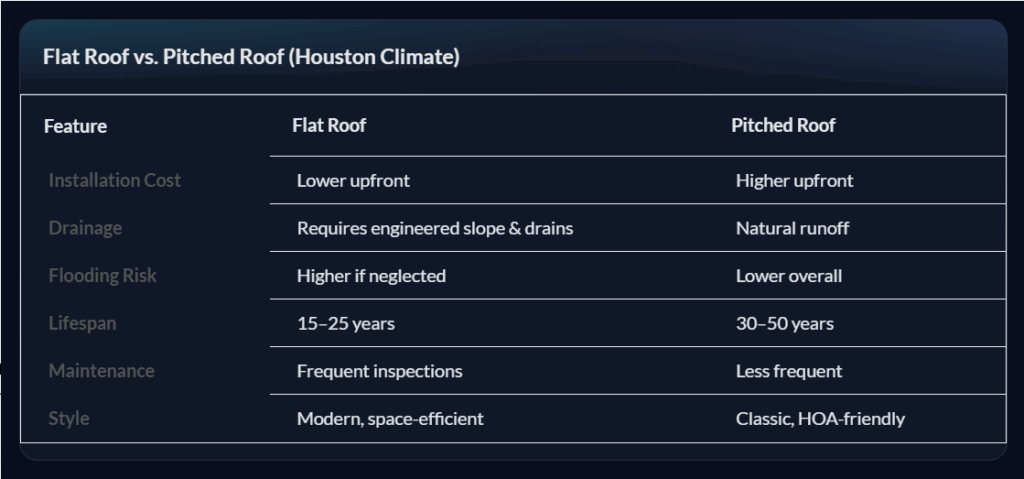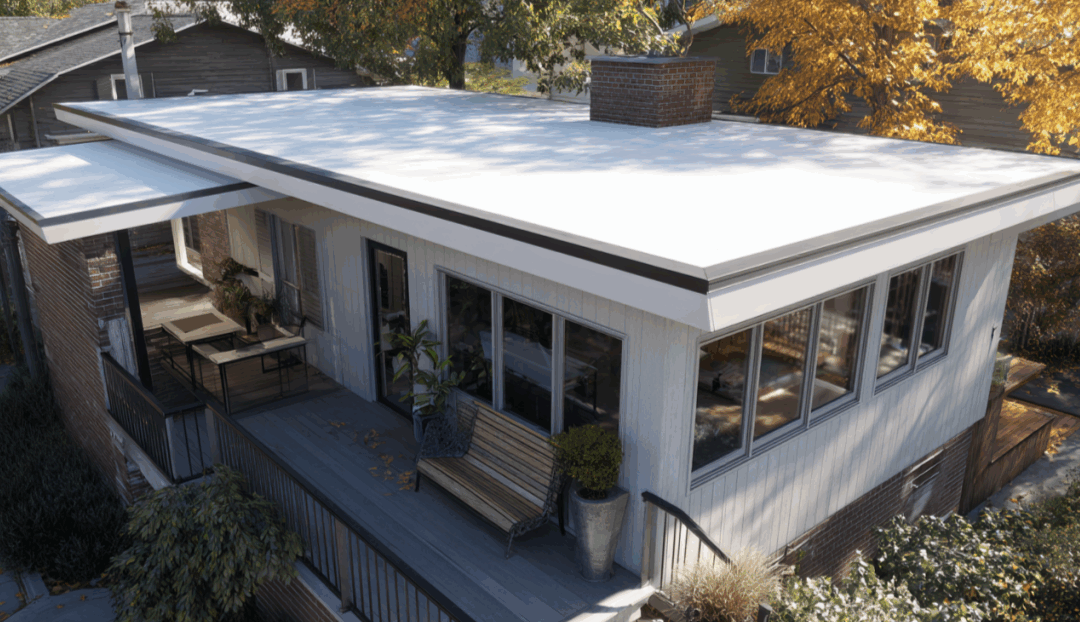If you live in Houston, you know the rain doesn’t just fall, it comes down in sheets. For homes with flat roofs, that can mean water pooling quickly and turning into flooding roof issues that no homeowner wants to deal with.
The truth is, flat roofs can perform beautifully in our city, but only if their drainage is designed and maintained with Houston’s climate in mind. Without the right slope or routine upkeep, leaks and damage are almost guaranteed.
In this article, we’ll walk you through what every Houston homeowner needs to know about flat roof drainage, including:
- Why our weather makes drainage so important
- What to consider before choosing flat roofing
- The pros and cons of flat vs. pitched systems
- Simple steps you can take to protect your home
At EZ Roof & Construction, we make roofing easy. Let’s dive in so you can feel confident about your roof, rain or shine.
What Makes Flat Roof Drainage a Challenge in Houston?
Flat roofs aren’t actually flat; they’re built with a small slope to guide water toward drains or scuppers. When that slope is designed correctly and drains are kept clear, your roof can handle storms with no problem.
But in Houston, it’s a different story. Torrential rains, tropical systems, and even hurricane downpours put enormous pressure on flat roofing. If water doesn’t move quickly, it can pool, seep into seams, and cause costly damage. That’s where most flooding roof issues start.
Many older homes and additions don’t meet today’s drainage standards for flat roofing in Houston, leaving them especially vulnerable. That’s why professional inspections and proactive upgrades matter so much; they ensure your roof is ready for the next storm, not just the last one.
Important Factors to Consider Before Choosing Flat Roof Drainage in Houston
Before you commit to a new flat roof or upgrade your drainage system, keep these essentials in mind.
Budget: What’s Realistic Now And Later?
Flat roofs are often less expensive to install, but they require ongoing care. Factor in maintenance and coatings to avoid surprise costs.
Drainage Design: How Is Your Roof Sloped?
Internal drains, gutters, or scuppers each work differently. The design must be tailored to your home’s layout to keep water moving.
Local Climate: How Much Rain Hits Your Area?
Neighborhoods along bayous or flood-prone zones need extra protection, like oversized drains or backup overflows.
Roof Use: Will People Walk On It?
HVAC units, solar panels, or rooftop decks change how water flows and add wear. The drainage system has to account for that.
Maintenance: Are You Prepared To Stay Proactive?
Flat roofs should be inspected yearly. If you’d rather not worry about it, partner with a contractor who can manage upkeep for you.
Warranty Coverage: Does It Include Ponding Water?
Not every manufacturer covers water damage. Be clear on what your protection actually includes before signing off.
Flat Roof vs. Pitched Roof Drainage in Houston

Flat roofs can absolutely work in Houston, but they demand attention. Pitched roofs naturally shed water, while flat roofs rely on careful design and maintenance.
Why Flat Roof Drainage in Houston Deserves Extra Care
Flat roof drainage is more than a design detail; it’s the difference between a reliable system and one that fails under Houston’s extreme weather.
Houston Rainstorms Push Roofs to the Limit
In just one storm, inches of water can collect on a poorly sloped flat roof. That pressure leads to leaks, weak spots, and costly repairs if left unchecked.
The Right Materials Make a Big Difference
TPO, PVC, and modified bitumen all perform differently under standing water. Choosing wisely with a local expert ensures durability.
Warranties May Not Cover Pooling Problems
Many warranties exclude ponding water damage. Keeping drains clear and slopes intact protects both your roof and your coverage.
Insurance and Resale Value Are On the Line
Buyers and insurers are cautious about flat roofs. A solid drainage system reassures both, protecting your investment long-term.
Is a Flat Roof Right for Your Houston Home?
Flat roofs can be modern, affordable, and practical, but only with reliable drainage. Here’s a quick checklist:
- Confirm slope is at least ¼ inch per foot
- Choose membranes rated for ponding resistance
- Schedule annual inspections and cleanouts
- Add emergency overflow scuppers if needed
- Keep warranties and insurance active
With proper care, flat roofing in Houston homes can perform beautifully, even in our stormy climate.
Flat Roof Drainage Houston FAQs
What Is the Best Flat Roof Drainage System in Houston?
The best flat roof drainage system in Houston combines a slight slope with internal drains or scuppers to move water quickly off your roof.
How Do Flooding Roof Issues Affect Flat Roofs?
Flooding roof issues in Houston often cause leaks, membrane wear, and even sagging structures. Regular inspections and clear drains prevent these risks.
Is Flat Roofing Houston Homes More Prone to Leaks?
Flat roofing on Houston homes can be more prone to leaks if drainage is ignored. With proper slope and upkeep, they can handle storms reliably.
Can Flat Roofs Handle Houston’s Heavy Rains?
Yes, flat roofs can handle Houston’s heavy rains when designed and maintained properly. Quality membranes and oversized drains make all the difference.
Protect Your Houston Home With Confidence
When the next storm rolls through, the last thing you want is to worry about leaks and water damage. With EZ Roof & Construction, you don’t have to. We design and install flat roofs with reliable drainage, backed by lifetime warranties and 24/7 emergency service.
For over 15 years, we’ve been Houston’s trusted local roofing experts, helping homeowners protect what matters most. From inspections to full replacements, we make roofing easy.
Schedule your free inspection today and let us protect your home against flooding roof issues.



